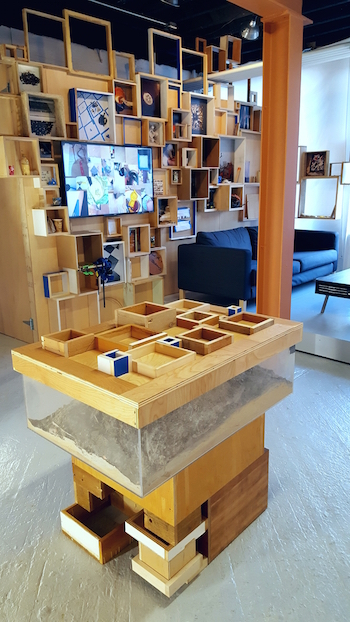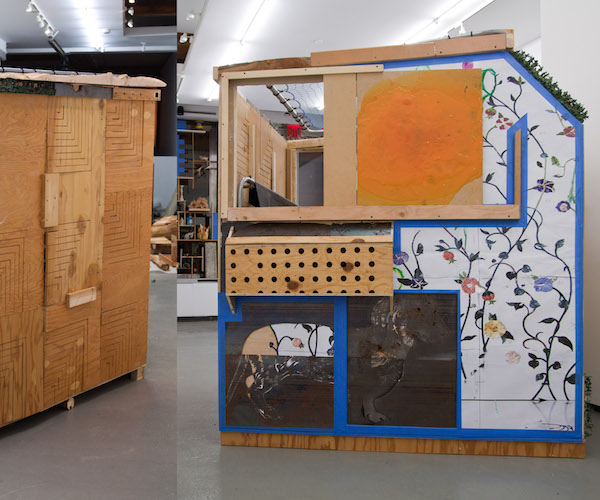Visual Arts Interview: Doug Weathersby — Making Art Out of Work
Among other things, we talked about the art world’s massive hoarding problem.
By Stace Brandt

Photo log entry from April 28, 2016. Photo: courtesy of Doug Weathersby.
When Doug Weathersby walks into your home he sees the dusty furnace, the unfinished kitchen, and the forgotten heap of decades old boxes in the basement. He sees the state of disarray not only for professional reasons — after all, you’ve requested his cleaning services — but as an inspiration for his art. For over 15 years, Weathersby has sustained himself financially and creatively by means of overdue odd jobs and home repair projects. His company, Doug Weathersby’s Environmental Services LLC. successfully integrates conceptual thinking and artistic vision with everyday tasks.
Weathersby graduated with a BFA from the Atlanta College of Art (now the Savannah College of Art and Design) in 1995. In 2002, he received his MFA in painting from the Massachusetts College of Art and a year later Weathersby was awarded the Boston ICA’s Artist Prize. Since then, Weathersby has dedicated himself to carving out a space that sits somewhere between the art world and everyday life: he documents his projects through a daily photo log and repurposes scrap materials from jobsites in gallery installations.
His recent solo exhibitions include Paint Shed Showcase at the Solomon Projects in the Atlanta, Georgia and What is Yours is Mine at former Dodge Gallery in New York. Weathersby’s current show, A Year in Review, is on view at VERY in Boston until February 25.
I called Weathersby early one morning recently to ask him to reflect on his work. Though he was already on a job, he kindly took some time to walk me through his transition from painting student to handyman-artist. He explained to me the challenges presented by his approach: how he works at a jobsite and then justifies using leftover construction material in galleries. We also talked about the art world’s massive hoarding problem.
Arts Fuse: You were a painting major in graduate school. What caused you to start heading in a different direction?
Doug Weathersby: In grad school the main thing I discovered was that I wasn’t a painter. I realized that I was making things that looked like paintings but they weren’t covering formal painting issues. They were more about process and material. I was more excited about making a stretcher or a frame and putting paint down on a board and layering it—more like painting a house.
AF: When did you start working as handyman and when did that work begin to fuse with your art?
Weathersby: It developed in grad school. I was focused in on the process of making and it felt like a meditative process— a process of paying attention to every moment. I started setting up different scenarios where I would, let’s say, remove every staple from all the bulletin boards on a floor of the school or sweep the halls as a practice and a performance. For my thesis show I cleaned my studio and then cleaned from my studio to the gallery and then the gallery itself. The material I amassed was essentially the show. I realized after having practiced cleaning and building that I was pretty good at it. That developed into the idea of combining my livelihood and my art.

Installation shot from “A Year in Review” at VERY on view through Feb 25. Photo: courtesy of Doug Weathersby.
AF: What’s behind the name “Environmental Services”?
Weathersby: The words “Environmental Services” brought to mind issues of site and dealing with your specific home or work environment. The inspiration comes from Joseph Beuys and his idea of being a social sculptor. He believed that we are manipulating our environments at all times. For artists, it’s not just when we’re painting or making a sculpture that we’re making art, but also while we’re living our lives and doing daily work.
AF: When you first approach a job, are you coming at it from the perspective of a handyman or does the artist in you begin to sculpt the space?
Weathersby: I would say it’s ninety percent just being a handyman. Ninety-nine percent of the time I’m trying to be as efficient as possible while doing the functional work. It’s more about a perspective. I’m periodically self-conscious about what I’m doing, where I am, and the dynamics of that environment both physically—how the light is, the dirty or very immaculate condition of it— and the social constructs generated by employee-employer relationships. I do sometimes take pictures at the job site, but any sculpture that I make is almost always after the fact or has to do with me removing something unwanted from the job and repurposing it.
AF: Your work is highly self-referential, but also fully dependent on the spaces and materials of others. How does collaboration factor into your work?
Weathersby: The amount of collaboration is different for each project. One form of collaboration is that I’m reacting to basic commands of the client about what to do on the job. Another form that is much more intimate is that I work with a lot of other people. There is a lot of conversation at the job site and there have been many times that somebody has pointed out to me what ends up being the image in my daily log.
AF: Despite your co-workers having influence on the subjects of your photographs, there’s something very solitary and personal about the log entries. They seem to sit somewhere between a haiku and a grocery list. Does this way of documenting your process feel at all meditative to you?
Weathersby: I don’t know if it’s meditative per se, but it’s a way to orchestrate my day and keep myself grounded. I’m a very disorganized person and I probably need even more organization than the logs. It’s also a way for me to record functional items that I have to keep for tax documents as well as my daily life. If I didn’t do the logs I probably would not remember sixty percent of the stuff that I do.
AF: There is a playful and ironic quality to your gallery installations that resists some of the customary art world stiffness. How much of this is a conscious rebellion?
Weathersby: I definitely have a tendency to want to rebel but I also don’t at all. I think of the gallery as a store. When advertising for my company, I often call things for sale “the products.” That’s how I reconcile putting my work in galleries, by acknowledging that my company is a commercial enterprise and so is the gallery.
AF: Do you keep your art after gallery shows?
Weathersby: What’s fun for me is making the object, not hoarding it …even though I do lots of hoarding.

Image from show “What’s Yours Is Mine” at DODGEgallery in 2013. Photo: courtesy of Doug Weathersby.
AF: Would you say hoarding is a problem for you?
Weathersby: I have a hoarding issue [laughs]. I think art collecting is a form of hoarding. A lot of art and materials are bought and then stored in places whether on walls, in closets, or storage facilities. There’s a lot of hoarding that goes on in this world from blue-chip art collectors to artists like myself. I think a lot of artists are hoarding potential materials to make things with.
AF: For your solo show What is Yours is Mine, you cleaned out the studios of some fellow artists that were represented by the former Dodge Gallery and built a dumpster out of artwork they had given you that they didn’t want anymore. Jeff Perrott called this your “Erased deKooning moment, but without Rauschenburg’s aggressive wish to eclipse, devour, or kill the other.”
Weathersby: [Laughs] I kind of felt like I was writing my name over theirs and sometimes next to them, but not erasing their names. Getting somebody else’s work is a powerful gift. They made work and then gave it to me knowing that I was going to change or destroy it. They also gave me their name and reputation.
AF: What’s Yours is Mine was also different from your usual work because it was very much centered on a gallery rather than home repair jobs. What stimulated that decision?
Weathersby: I wanted to do a show that was different than some kind of work project. I was collecting old art from other gallery artists and then making it mine. It was a kind of insular recycling project inside of the gallery. It also came from this idea that I think about a lot, which is that the moment anything is made its immediately returning to dust. I often think about the preciousness of objects and how it’s all just material. I think I’ve thrown away or destroyed my own art because once it’s made it starts to die.
AF: Your most recent show is called A Year in Review. The title speaks for itself, but is there any specific message that you were trying put across at with this installation?
Weathersby: I wanted to talk about material as documentation. The frames in A Year in Review I called “modular storage.” They’re made from a bunch of different jobs I did throughout the year. What we keep is a reflection of who we are. All of the material in the show is stuff I decided to keep. I organized it in an attempt to, — to what? To slow its march to dust? I don’t know — to enjoy it a bit longer? To remember it? To reflect on it. The things I keep define me. I define myself by the things I keep.
Stace Brandt is a local artist, musician, and arts writer. She recently graduated from the University of Vermont with her Bachelor of the Arts in Studio Art and English. A multidisciplinary writer, Stace has contributed to print and web publications including Seven Days Vermont and Big Red & Shiny.
Tagged: A Year in Review, Doug Weathersby, Doug Weathersby’s Environmental Services LLC, Stace Brandt
